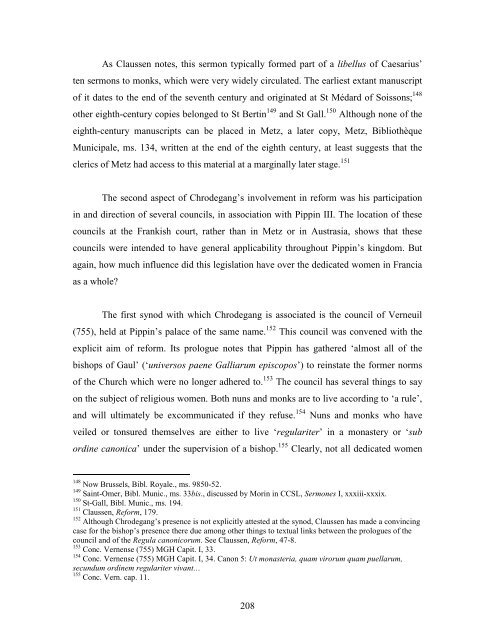Lindsay Rudge PhD Thesis - University of St Andrews
Lindsay Rudge PhD Thesis - University of St Andrews
Lindsay Rudge PhD Thesis - University of St Andrews
You also want an ePaper? Increase the reach of your titles
YUMPU automatically turns print PDFs into web optimized ePapers that Google loves.
As Claussen notes, this sermon typically formed part <strong>of</strong> a libellus <strong>of</strong> Caesarius’<br />
ten sermons to monks, which were very widely circulated. The earliest extant manuscript<br />
<strong>of</strong> it dates to the end <strong>of</strong> the seventh century and originated at <strong>St</strong> Médard <strong>of</strong> Soissons; 148<br />
other eighth-century copies belonged to <strong>St</strong> Bertin 149 and <strong>St</strong> Gall. 150 Although none <strong>of</strong> the<br />
eighth-century manuscripts can be placed in Metz, a later copy, Metz, Bibliothèque<br />
Municipale, ms. 134, written at the end <strong>of</strong> the eighth century, at least suggests that the<br />
clerics <strong>of</strong> Metz had access to this material at a marginally later stage. 151<br />
The second aspect <strong>of</strong> Chrodegang’s involvement in reform was his participation<br />
in and direction <strong>of</strong> several councils, in association with Pippin III. The location <strong>of</strong> these<br />
councils at the Frankish court, rather than in Metz or in Austrasia, shows that these<br />
councils were intended to have general applicability throughout Pippin’s kingdom. But<br />
again, how much influence did this legislation have over the dedicated women in Francia<br />
as a whole?<br />
The first synod with which Chrodegang is associated is the council <strong>of</strong> Verneuil<br />
(755), held at Pippin’s palace <strong>of</strong> the same name. 152 This council was convened with the<br />
explicit aim <strong>of</strong> reform. Its prologue notes that Pippin has gathered ‘almost all <strong>of</strong> the<br />
bishops <strong>of</strong> Gaul’ (‘universos paene Galliarum episcopos’) to reinstate the former norms<br />
<strong>of</strong> the Church which were no longer adhered to. 153 The council has several things to say<br />
on the subject <strong>of</strong> religious women. Both nuns and monks are to live according to ‘a rule’,<br />
and will ultimately be excommunicated if they refuse. 154 Nuns and monks who have<br />
veiled or tonsured themselves are either to live ‘regulariter’ in a monastery or ‘sub<br />
ordine canonica’ under the supervision <strong>of</strong> a bishop. 155 Clearly, not all dedicated women<br />
148<br />
Now Brussels, Bibl. Royale., ms. 9850-52.<br />
149<br />
Saint-Omer, Bibl. Munic., ms. 33bis., discussed by Morin in CCSL, Sermones I, xxxiii-xxxix.<br />
150<br />
<strong>St</strong>-Gall, Bibl. Munic., ms. 194.<br />
151<br />
Claussen, Reform, 179.<br />
152<br />
Although Chrodegang’s presence is not explicitly attested at the synod, Claussen has made a convincing<br />
case for the bishop’s presence there due among other things to textual links between the prologues <strong>of</strong> the<br />
council and <strong>of</strong> the Regula canonicorum. See Claussen, Reform, 47-8.<br />
153<br />
Conc. Vernense (755) MGH Capit. I, 33.<br />
154<br />
Conc. Vernense (755) MGH Capit. I, 34. Canon 5: Ut monasteria, quam virorum quam puellarum,<br />
secundum ordinem regulariter vivant…<br />
155 Conc. Vern. cap. 11.<br />
208

















